If you are looking for an all-white chicken with a classic look to add to your flock, there are many excellent chicken breeds.
Whether you are looking for reliable layers or a friendly backyard chicken, breeders are producing more and more white varieties of the popular commercial and heritage chicken breeds.
A colorful flock includes the classic white, so we brought in some of our favorite all-white chicken breeds to show you.
Keep reading to learn more about their breed characteristics and see some great pictures of these beautiful birds.
Table of Contents
ToggleWhite Ameraucana

Although the Ameraucana chicken comes in several colors, the White Ameraucana adds its hawk-like characteristics to this classic-looking chicken plumage.
A relatively recent breed, it was developed in the 1970s and accepted as an official breed by the American Poultry Association in 1984.
The white variety of Americauna has pure white plumage, both beards and muffs, small pea combs, small or non-existent waddles, and reddish eyes.
The skin and bottom of their feet are also white.
White Ameraucanas are a dual-purpose breed good for both egg-laying and meat.
They are on the smaller side for a meat bird weighing about 5.5 to 6 pounds at their mature size.
Although they take a bit longer than other breeds to start laying, it is worth waiting for their 3 to 4 light blue-colored eggs per week!
It will take about 5 to 7 months before these birds start laying.
The blue egg gene in Ameraucanas also breeds true.
White Ameraucanas are hardy and independent birds, and they prefer to be free-range rather than confined.
They rarely go broody and are excellent foragers.
Araucana

The white Araucana is a less commonly found ancestor of the Ameraucanas.
They originated in Chile and were eventually brought to the United States to be bred into the Ameraucanas and Easter Eggers during the 20th century.
The Araucanas are most easily identified by their lack of tail and their stylish tufts sticking out from the side of each ear.
They are fairly small and mostly used for their beautiful egg colors in varying shades of blue.
Araucanas are fast-growing, so they will start to lay fairly soon.
They are seasonal layers, producing about 3 medium-sized eggs throughout the warmer months.
Many people find them to be very friendly birds and even cuddly with humans when socialized from a young age.
Related: How to tell how old a chicken is
Unfortunately, the gene causing their funny-looking ear tufts also causes them to have very low hatch rates.
For this reason, it is difficult to find Araucanas through commercial hatcheries.
If you are interested in this pure breed, search for breeders specializing in rare breeds.
White Barnevelder
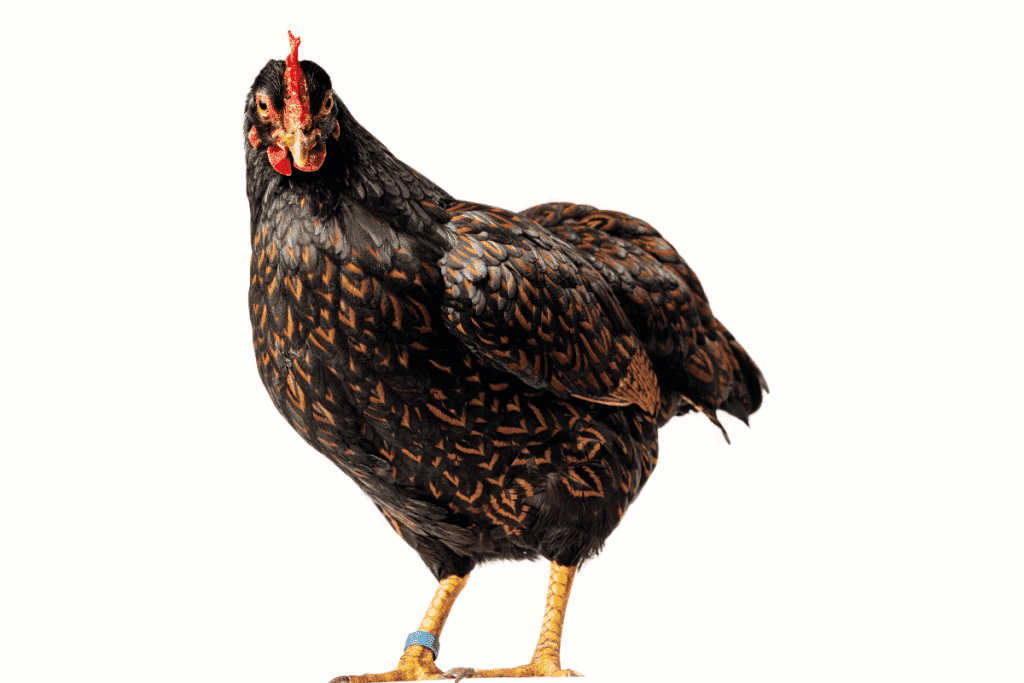
The White Barnevelder is a Dutch breed developed during the 19th century.
These are beautiful birds with the classic all-white aesthetic.
They have pure white feathers and bright yellow feet.
Interesting read: Do chickens have knees?
Other color varieties of this breed include solid black and double-laced.
A smaller, white Bantam variety is produced from crossing Barnevelders with White Wyandottes, but it is not a true Bantam breed.
This dual-purpose breed is particularly valued for its chocolate brown-colored eggs and excellent egg production.
They will lay about 3 medium-sized eggs per week.
One advantage of this white chicken breed is its winter hardiness.
It will lay a steady amount of eggs even in the cold months.
It will tolerate confinement well, but as an active breed, it will enjoy having roam space.
White Barnevelders are friendly and active birds.
This docile breed makes an excellent choice for a family chicken/pet.
The white variety of this breed is currently not officially recognized by the American Poultry Association and therefore does not have an official breed standard.
Further Reading: Barnevelder Chicken Egg Guide
White Australorp
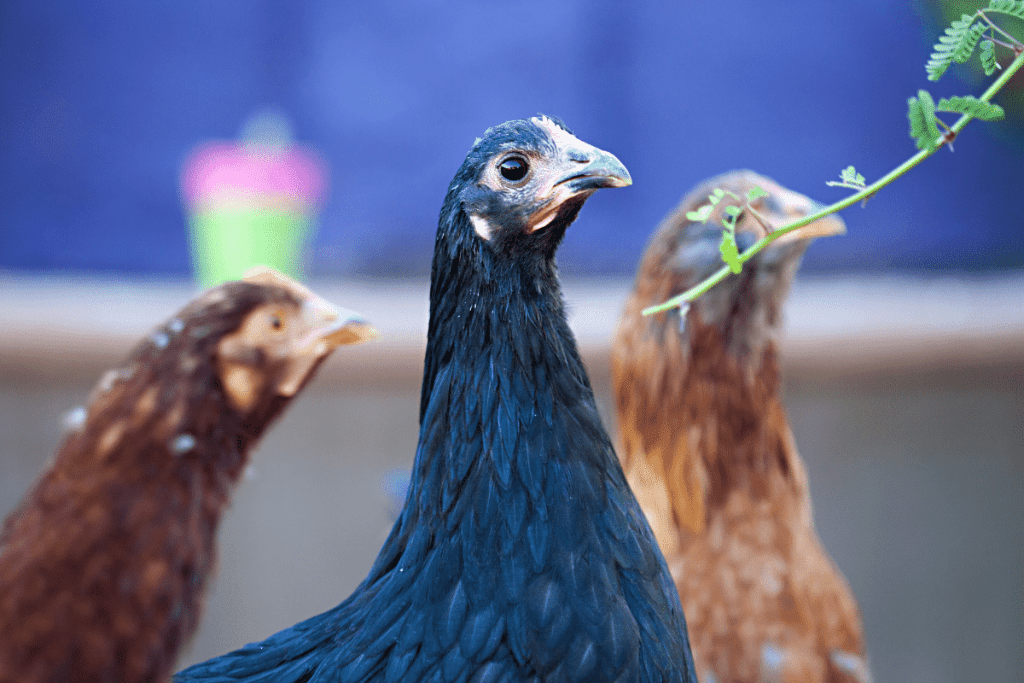
The Australorp chicken was produced in Australia by cross-breeding the English breed Ostrolorps with Rhode Island Reds, Minorcas, White Leghorns, Langshan, and potentially other breeds.
Although the original Australorp has black plumage, the white Australorp is an officially recognized variety in Australia.
Sometimes referred to as the Austra White, it is a cross between a Black Australorp and a White Leghorn.
The body size of the White Astralorp is large. It is a heavy breed and makes a good dual-purpose chicken.
The males average 8.5 to 10 pounds, and the hens average 6.5 to 8 pounds.
In the early 20th century, the Australorps in Australia were truly prolific layers, often entering into egg-laying contests and producing up to 350 eggs in a year!
The record was an astonishing 364 eggs in one year.
Modern-day Australorp hens are not so prolific, but they still lay about 250-300 eggs per year.
The eggs of these white chickens are medium-sized and light brown.
The White Australorp is known to be a particularly quiet and gentle breed.
This friendly temperament makes it a popular breed for pet chickens, people looking for many eggs from fewer birds, and people raising birds for fairs.
This breed of chicken is well adapted to both hot and cold weather.
White Leghorn
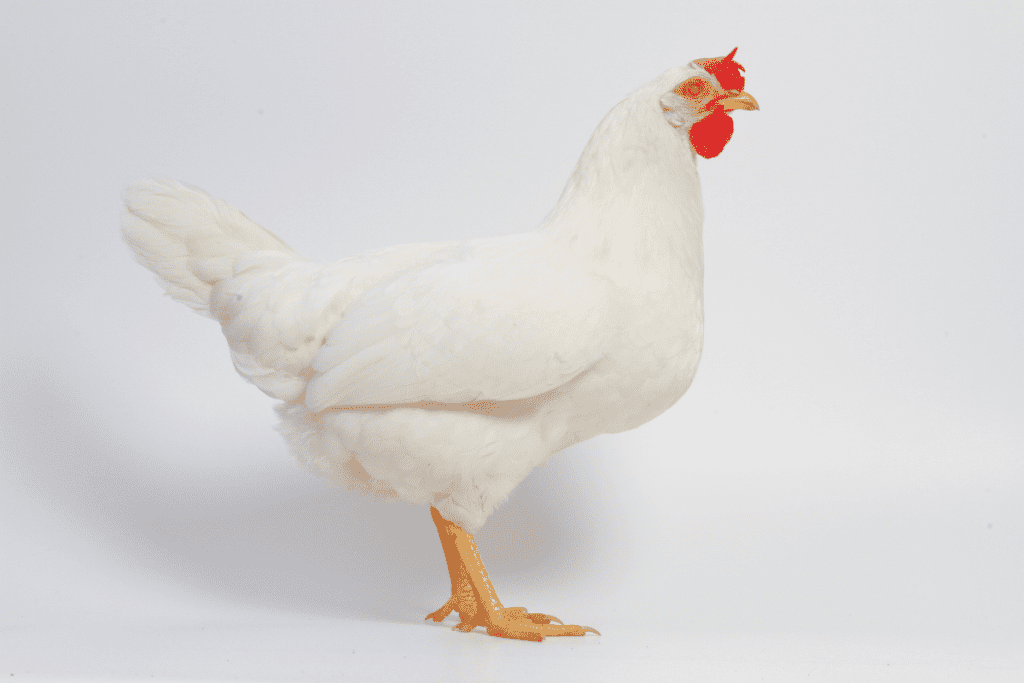
White Leghorns are a weather-hardy breed of chicken originating from Italy.
Their name comes from the city name “Livorno,” the city from which they were first imported into the United States.
The White Leghorns have all-white feathers, yellow skin, yellow legs, white earlobes, and a thin, sleek body.
They can either have a rose comb or a single comb.
This breed is rarely broody and matures quickly.
It is primarily used as an egg-laying chicken rather than for meat production as a fairly small bird.
White Leghorns are excellent egg layers.
They produce 220-330 large to extra-large eggs per year.
White Leghorns are very active birds and thrive as free-range chickens.
Although the white variety is more vulnerable to predators due to its lack of camouflage, these birds are generally tough and efficient foragers.
Their temperament is flighty and nervous, so they are not a good choice for a lap chicken.
White Leghorns are sometimes confused with the Silver Leghorn, an autosexing breed.
The White and Silver Leghorns are distinct color varieties, and White Leghorns are not an autosexing breed.
Related: Can you eat leghorn chickens?
White Silkies
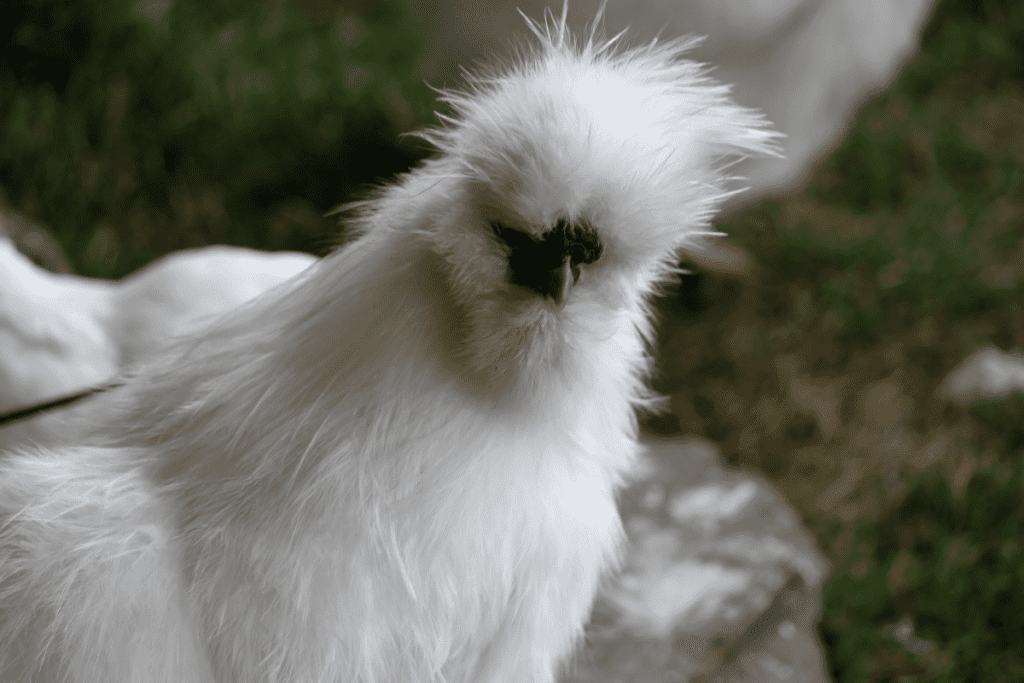
White Silkies are the most common color variety of Silkies.
Unlike some other breeds with a more “classic” aesthetic, Silkies have a truly one-of-a-kind style, with their super fluffy hair-like feathers.
Their beautiful plumage extends from the top of their head down to their feathered shanks.
Check out more chickens with feathered legs in our list.
In addition to their white plumage, Silkies are known for the unusual black color of their beaks and skin.
Their black-colored bones are even more unusual than the white feather and black skin combination!
Although they are not considered excellent layers, they make a very good exhibition bird if you are interested in showing them.
They lay about 100-120 small eggs with a cream or white eggshell color.
Silkies are also very docile birds, and they are a solid choice for a cuddly and soft pet chicken.
White Plymouth Rock
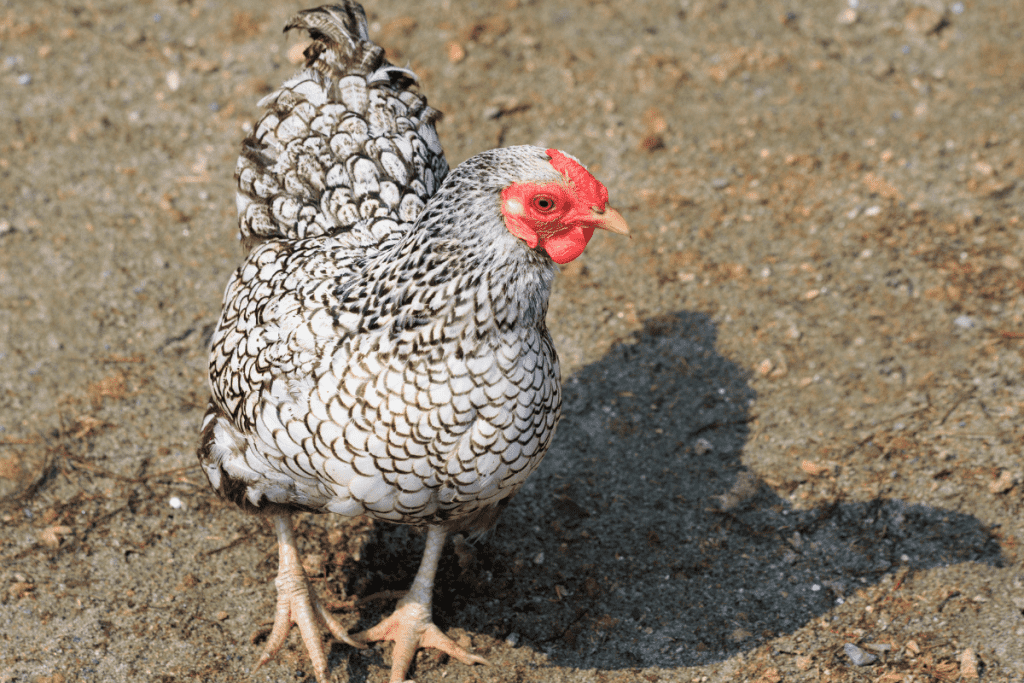
The White Plymouth Rock chicken, also known as White Rock, is a lovely medium-sized all-white bird originating from Massachusetts during the 19th century.
It was bred largely from the Barred Plymouth Rock breed and had many similar characteristics to the Barred Plymouth Rock.
The White Rock breed has yellow legs, and the chicks have yellow combs, which become bright red as they mature.
White Plymouth Rock is an excellent breed for meat production due to its fast growth and flavorful meat.
They are fair layers, producing about 220 eggs per year.
These birds are also excellent winter layers, making them great for reliable, year-round laying. White Rocks begin laying large, light-brown eggs at about 5 months old.
Due to their Northeast origin, it is a cold-hardy breed, but their combs are still susceptible to frostbite.
Rhode Island White
The Rhode Island White is an all-white breed developed during the 19th century in Rhode Island.
It has a medium body size, a long and broad “brick” body shape, and a rose comb.
The young chicks are born a light yellow color and attain their white color in the adult phase.
Rhode Island Whites lay about 200-250 eggs per year (4-5 per week), and they continue to lay during the winter months.
They are not known as a broody breed and will lay reliably starting from about 6 months.
Some particular strains of Rhode Island White are bred to be good meat birds.
These strains tend to be fast-growing and weigh about 5.5-7.5 pounds.
Rhode Island Whites are often mistaken for a Rhode Island Red with a different feathering color, but these are, in fact, two distinct breeds.
As a friendly and easygoing bird, the Rhode Island White is good for backyard chicken raisers.
If you want to see the Rhode Island Red, check out our list of red chicken breeds.
White Croad Langshan
The Croad Langshan is an ancient chicken breed originating from China.
Although the traditional Croad Langshan has only black feathers, the white color pattern has appeared more recently in Australia, starting in 2013.
The White Croad Langshan is one of the larger chickens, with long legs, a high tail, and an upright stance, giving it the overall appearance of a very regal bird.
This heavy bird weighs approximately 7.5-10 pounds.
In addition to a large amount of meat they can produce, these chickens lay about 180-240 eggs per year.
Their egg size is large, but even more impressive is the rare, dark brown, and purplish color of their eggs.
White Croad Langshans have a friendly temperament and make an excellent dual-purpose bird.
The hens make good mothers, but they sometimes risk breaking eggs due to their large size, especially in small chicken coops.
Some hens will also decide to end their setting period early.
White Wyandotte
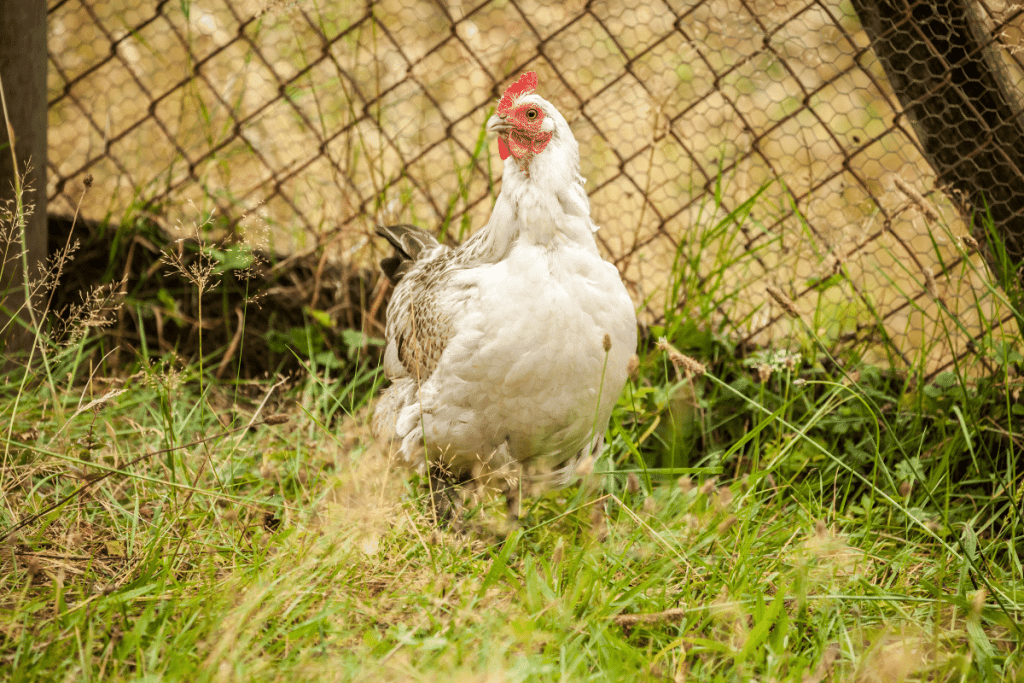
White Wyandotte is a large dual-purpose American breed of chicken valuable for its eggs, meat and as an ornamental breed for showing purposes.
According to the American Poultry Association, the White Wyandotte has been an official breed since 1888 (the Silver-Laced Wyandotte was the original Wyandotte accepted in 1883).
It has pure white, soft feathers, yellow skin, legs, and rose combs.
They have a heavy, round body type.
Adult females weigh about 6.5 pounds, and adult males weigh about 8.5 pounds.
This breed is very well-rounded (both physically and practically speaking!) and low-maintenance.
White Wyandottes are cold-hardy, and they also tolerate hot climates fairly well.
It produces over 200 large brown eggs per year, and they do not tend to get broody.
The White Wyandotte matures faster than many other breeds, and it provides a good amount of quality meat.
White Wyandottes also have a reputation for being extremely docile birds.
Although its population declined during the rise of industrial chickens, this heritage breed is gaining in popularity among people looking for friendly chickens for their backyard flock.
White Orpington
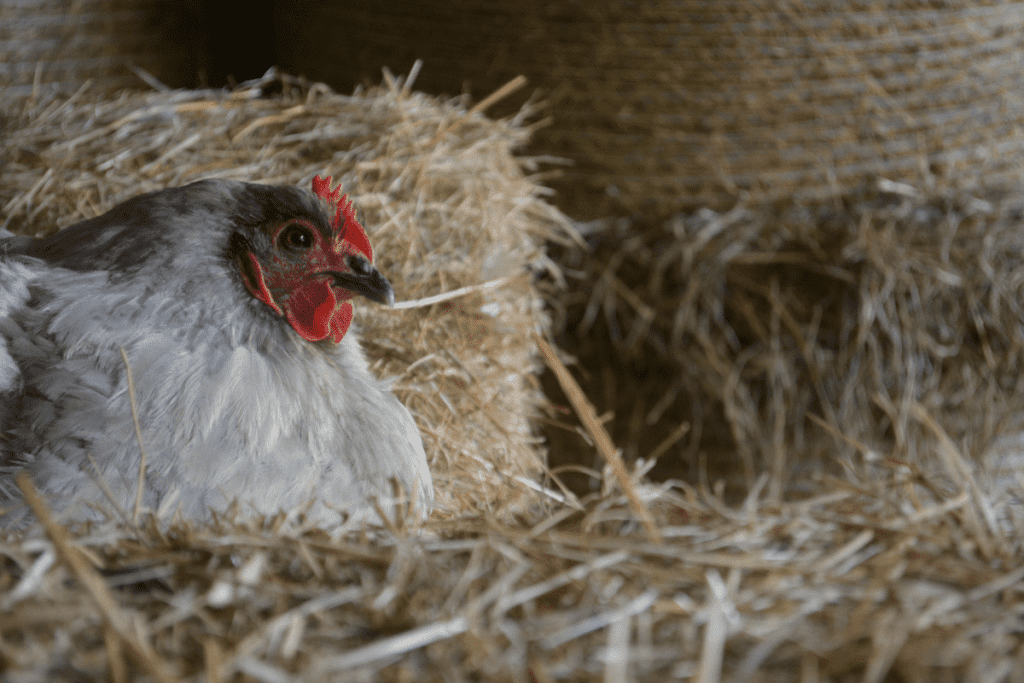
The White Orpington is a large, all-white multi-purpose breed used for meat, eggs, and shows.
Orpington is a heritage breed developed by William Cook in the late 19th century in London.
They have a single comb and pinkish-white legs, and white skin.
White Orpingtons are a very heavy breed.
The adult hens weigh about 8 lbs, and adult roosters weigh 10-12 lbs.
On the flip side, you will need to provide shade and plenty of water to prevent them from overheating during the hot summer months.
Check these birds regularly for fleas and mites.
Their dense feathering makes them extra susceptible to these issues.
They are very good layers, and they produce about 140-220 brown eggs per year.
White Orpingtons take 5 months to reach maturity.
These birds are not very active and do not tend to be good foragers, but they have a calm and easygoing temperament.
They make a good lap chicken in addition to being highly productive.
White Orpingtons tend to be very broody and will readily set eggs.
White Jersey Giant
The White Jersey Giant chicken originated in New Jersey in the late 19th century.
As you might guess from the name, this chicken is the largest of all purebred domestic chickens.
Jersey Giants also come in Blue and Black varieties.
It is considered a dual-purpose breed but larger than most dual-purpose breeds.
The roosters weigh up to 13 pounds, and the hens weigh 10 pounds.
The chicks are born gray and eventually mature into their pure white plumage.
White Jersey Giants produce about 180-260 brown eggs per year.
They are slow-growing and take about 24 months to reach their full size.
This breed is also known to have a friendly and docile temperament.
Continue reading: Jersey Giant Chicken Eggs: Guide And FAQ
How useful was this post?
Click on a star to rate it!
We are sorry that this post was not useful for you!
Let us improve this post!
Tell us how we can improve this post?
